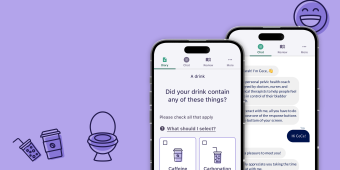Every industry has a human element, but designing for healthcare means understanding that connection is the heart of medicine.
All the new medicines and advancing technologies in healthcare mean nothing without the interactions between doctors and patients. When a person walks in complaining of an ache or pain, the doctor’s job is to use their knowledge and intuition to tease out details and offer a diagnosis. That process is intrinsic to the profession, and it’s why the doctor-patient relationship is so sacred.
It’s also the same process we use when building software for healthcare providers.
Prep yourself to build the best software for healthcare with these 6 planning steps
Facilitation is what drives innovation in healthcare software applications. We listen and learn, then find ways to make things more transparent for users on either end. We can create tools that help patients feel cared for with a human-centered design process. Moreover, we can give providers the data they need to deliver better-quality care.
Today, TXI has worked on everything from an app to educate doctors with interactive CME-crediting lessons to software that connects homecare providers with clients and their families. Over those and other projects, we’ve picked up a few lessons on how to design healthcare software with a human-centered mindset.
Here, we’ll go deeper into a few of those lessons. But first, a look at the regulatory landscape that makes designing for healthcare stand out.
Regulation makes healthcare software design completely different from consumer-oriented tech
When we’re working on consumer product design, there are two things we’re balancing: the needs of the business and the needs of the user. When we started building healthcare software products, we had to figure out how to accommodate a third constraint: regulation.
Patients entrust healthcare providers with their most sensitive health information, from test results to medical diagnoses. Regulatory compliance is key to maintaining a quality, trust-centered patient experience that leads to positive health outcomes.
Healthcare regulations influence many decisions healthcare professionals make, playing a role in everything from how they record and store data to how they prescribe treatment. Malpractice is a major fear, and for good reason. That’s why everything in the industry is put under the microscope, to keep practitioners from making themselves any more liable than they need to be.
Keeping all protected health information (PHI) stored securely to stay on the right side of HIPAA regulations is a unique challenge in the healthcare industry. And while the bulk of the pressure falls on strong development and security work, HIPAA compliance also extends to design, informing how we manage interactions that deal with PHI.
When designing for healthcare, we have to be conscious of what hesitance medical professionals may have and which regulations may slow us down. That means actively listening to providers about specific compliance challenges and concerns.
For example, a provider might note that their office struggles to securely transmit patient data across devices. Teams can apply this insight to their product design via software features like secure access controls, data encryption by default, and in-app reminders about compliant data handling practices.
We also have to work with healthcare providers to turn off their inner regulators so we can let ideas take shape without shutting them down. The key is to work with providers to develop as many product ideas as possible. Then, you can workshop them until you’ve zeroed in on a solution. After that, we know that any health software we develop will be regulated as thoroughly as everything else in the industry.
This ideation methodology—going big before going small—is a major aspect of design thinking. It takes a lot of bad ideas to find a good one. With enough ideas on the table, teams can refine toward a digital health solution that drives value for patients and providers.
Custom healthcare software development relies on healthcare providers’ trust
We’ve written a whole article on how healthcare software companies and healthcare providers can work together, but it’s worth pointing out again here how different the cultures are.
Because of their regulatory mindset, many people in the healthcare industry can be hesitant to move at the pace healthcare software developers are accustomed to. After all, many medical professionals spend the bulk of their careers removed from tech, not because they don’t have an interest, but because it’s a traditional and siloed industry.
New software in healthcare can make doctors reluctant, not because they don’t see the benefits, but because they are busy enough with the work in front of them. Learning a new tool and integrating it into your practice can feel like a major obstacle.
These cultural aspects don’t always align with the way designers think and operate. But it’s important to approach a provider partnership with an open and empathetic mind. One way to do that: weave empathy into the user experience for providers.
For example, many providers are used to working with clunky electronic health record systems. Designers can talk to providers about existing pain points, like complex menu options or text-only data readouts. Then, they can brainstorm ways to solve those problems with their software solution, e.g., via simpler menus or in-app data visualizations. The result: a seamless, empathy-driven product that’s optimized for usability—and that can deliver real value.
Throughout the design process, remember: the goal of a healthcare software developer shouldn’t be to force practitioners to work at a speed they’re uncomfortable with. It should be to find a middle ground, because we’re designing for them, not the other way around. If we want to sprint and they are more inclined to crawl, we work to establish a pace that allows us to walk comfortably side by side.





